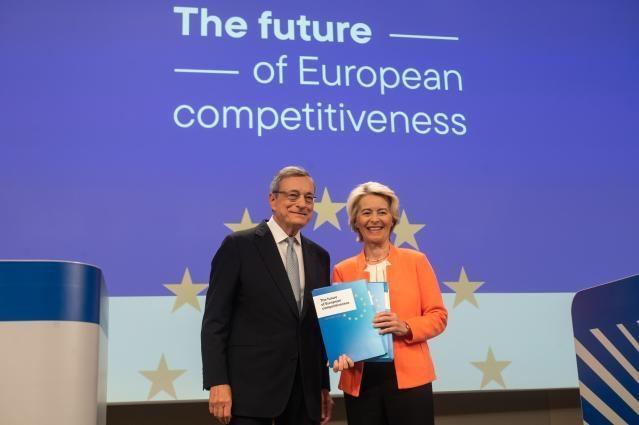9 September 2024 | Brussels
On September 9th, the highly anticipated report on the competitiveness of the European Union was officially released on the EU Commission’s website and presented to the public. Signed by Mario Draghi, former President of the European Central Bank and former Prime Minister of Italy, the report – titled “The future of European Competitiveness”- offers valuable insights into the economic challenges and opportunities facing the EU.
A new European industrial strategy
The report is divided into two parts. The part A aims at laying out a new industrial strategies for Europe to overcome historical barriers to growth such as a lack of focus on clear and common priorities, a waste of common resources due to dilution in several national and EU instruments and a lack of coordination.
This first part of the report outlines three key areas for action:
- Closing the innovation gap: The report attributes Europe’s productivity lag behind the U.S. since the mid-1990s to its failure to fully embrace the digital revolution. This gap has led to slower economic growth and GDP compared to both the U.S. and China, which has outpaced Europe in key digital innovations. Artificial Intelligence is seen as a vital opportunity for Europe to close this gap, with a strong focus on addressing skill shortages.
- A joint decarbonization and competitiveness plan: The report stresses the need for the EU to balance its decarbonization targets with industrial competitiveness. It proposes a plan with three priorities: lowering energy costs by passing on decarbonization benefits, capturing green transition opportunities by leading in clean tech innovation and manufacturing, and ensuring fair competition through trade measures when necessary.
- Increasing security and reducing dependencies: In light of recent geopolitical events, the EU’s reliance on raw materials is highlighted as a vulnerability. The report calls for a “foreign economic policy” to secure critical raw materials, increase domestic production, and promote recycling and innovation in alternative materials.
More investment in infrastructures and less fragmentation: the proposals for the European transport sector
Part B of the report provides specific analysis and recommendations for different economic sector, and, among them, the transport sector.
The report defines the transport sector as a “complex and diversified” industry, nonetheless, it recognizes that transport operators face common challenges. Regarding the TEN-T, the report notes that massive investments are required to complete missing links and modernize the transport infrastructure, and yet the measure is not accompanied by a comprehensive ex-ante plan to secure the necessary financing and investment (namely 845 billion EUR until 2040).
The report also highlights that the investments in the maintenance of infrastructures for land transport remain too low and that complex and diverging administrative rules constitute a barrier to the realization of transport infrastructure projects. Finally, an excessive fragmentation of traffic rules and basic vehicle standards is seen as a major constraint to innovation in the road transport sector.
In order to overcome these barriers, the report ends up with the following proposal for decarbonization and innovation in road transport:
- Grid and telecom networks availability should be secured to deliver a modern and extended charging infrastructure for road vehicles:
- National barriers should be lifted, and operators should benefit from open markets to deliver services across borders.
- Digitalization of the sector should be enhanced by the deployment of cooperative intelligent transport systems and the centralised coordination of the deployment of cooperative, connected and automated vehicles.
- Measures to support the heavy-duty vehicles transport sector in meeting the EU decarbonization targets.
- Secure a certain degree of EU autonomy in the supply chain for sustainable, renewable and low-carbon fuels.
Overall, the report on competitiveness sets ambitious challenges, acknowledging in its introduction that achieving them would require increasing the EU’s investment-to-GDP ratio by around five percentage points annually, reaching levels not seen since the 1960s and 70s. For context, the additional investments provided by the Marshall Plan from 1948 to 1951 amounted to about 1-2% of GDP in recipient countries each year.
Check out and download the report at the link hereunder:

